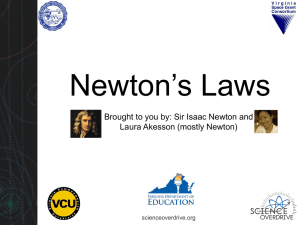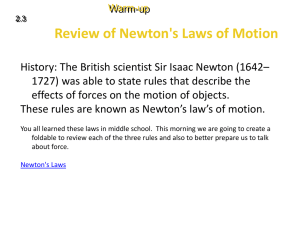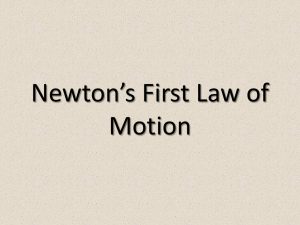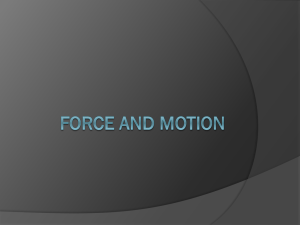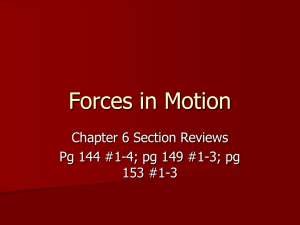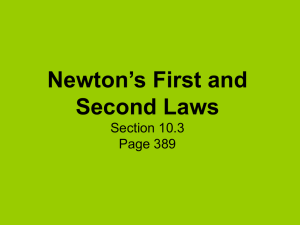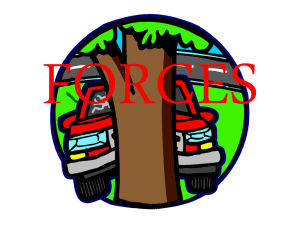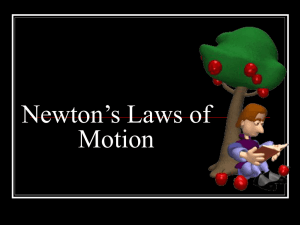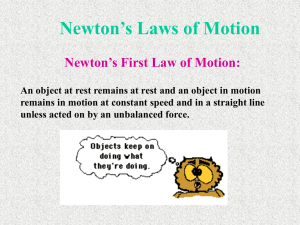Newtons Laws of Motion
advertisement
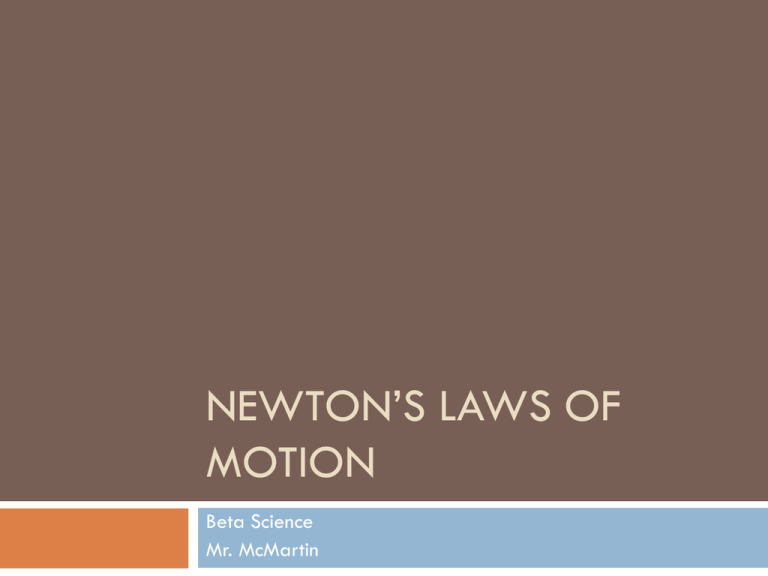
NEWTON’S LAWS OF MOTION Beta Science Mr. McMartin Newton’s Laws of Motion Imagine that you are playing baseball. The pitch comes in and- crack- you hit the ball hard! But instead of flying off the bat the ball just drops to the ground. Is that normal? Answer: You would probably say no. You know that force and motion are related. When you exert a force on a baseball it probably should move. In 1686, Sir Isaac Newton explained this relationship between force and the motion of an object with his three laws of motion. Newton’s First Law of Motion An object at rest remains at rest, and an object in motion remains in motion (at a constant speed and in a straight line) unless acted on by an unbalanced force. This law describes the motion of an object that has a net force of 0 N acting on it. This law is best understood when you look at it as two different parts… objects at rest and objects in motion. Objects at Rest An object that is not moving is said to be “at rest.” Ex.- chair on the floor, golf ball resting on a tee. Newton’s first law says that objects at rest stay at rest unless they are acted on by an unbalanced force. So a chair won’t slide across the room unless you push the chair. A golf ball won’t move off the tee unless the ball is struck by a golf club. Objects in Motion The second part of Newton’s first law is about objects moving with a certain velocity. These objects will move forever with the same velocity unless an unbalanced force acts on them. Ex. Driving a bumper car at an amusement park. If you drive straight and don’t run in to anyone you will continue on that path… when someone hits you, you will move in another direction. Friction and Newton’s First Law An object in motion will stay in motion unless it is acted on by an unbalanced force. In this case you should be able to push your desk across the floor and have it continue moving right? But if you were to push your desk it would stop after a very short time. Why? The unbalanced force acting on the desk would be friction. Inertia and Newton’s First Law Newton’s first law of motion is sometimes called the “Law of Inertia.” Inertia: the tendency of all objects to resist any change in motion. Inertia causes an object to stay in place until an outside force acts on it. It is also the reason objects stay in motion in a particular direction until an outside force acts on it. Mass and Inertia Mass is a measure of Inertia. An object that has a small mass has less inertia than an object with a large mass. It is easier to change the motion of an object with a small mass than it is to change the object with a large mass. Newton’s nd 2 Law Newton’s Second Law: The acceleration of an object depends on the mass of the object and the amount of force applied. This law describes the motion of an object when an unbalanced force acts on the object. Consider this law in two parts as well: Part 1: Acceleration Depends on Mass Part 2: Acceleration Depends on Force Acceleration Depends on Mass Suppose you are pushing an empty cart. You have to exert only a small force on the cart to accelerate it. But, the same amount of force will not accelerate the full cart as much as the empty cart. The acceleration of an object decreases as its mass increases and its acceleration increases as its mass decreases. Expressing Newton’s Second Law Mathematically This is the relationship of acceleration, mass, and force: A= F/M or F= MxA A=acceleration M= mass F= force What is the acceleration of a 3kg mass if a force of 14.4 N is used to move the mass? Newton’s rd 3 Law Newton’s 3rd Law: Whenever one object exerts a force on a second object, the second objects exerts an equal and opposite force on the first. Newton’s third law can be simply stated as follows: All forces act in pairs. If a force is exerted, another force that is equal in size and opposite in direction. The way that force pairs interact affects motion of objects Force Pairs Action and Reaction force pairs: Action forces: forces that are acted on objects Reaction forces: forces that push back on action forces. Ex. You exert a force on a chair when you sit on it. Your weight pushing down on the chair is an action force. The reaction force is the force exerted by the chair that pushes up on your body. The force is equal to your weight. Force Pairs Do Not Act on the Same Object A force is always exerted by one object on another object. This rule is true for all forces. However, action and reaction forces in a pair do not act on the same object. If they did, the net force would always be 0N and nothing would ever move! Ex. A swimmer’s hand exerts force on the water and the water exerts force on the swimmer’s hand. All Forces Act in Pairs- Action and Reaction Newton’s third law says that all forces act in pairs. When a force is exerted there is always a reaction force. A force never acts by itself. The Effect of a Reaction Can be Difficult to See Gravity is a force of attraction between objects that is due to their masses If you drop a ball, gravity pulls the ball toward Earth. This force is the action force exerted by Earth on the Ball Gravity also pulls earth towards the ball. The force is the reaction force by the ball on the earth You cannot see this force because the force of gravity created by the ball is so tiny due to Newton’s Second Law where the acceleration of objects is due to their masses.
